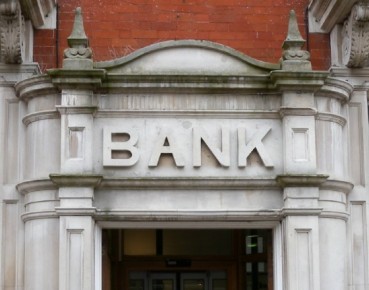
(Steve Parker, CC BY 2.0)
The average value of a transaction (the amount of the deposit) is nearly PLN70,000 (approx. EUR15,000) which indicates that these are deposits made by affluent individuals, sole proprietors, farmers, and not large companies.
The WIBOR no longer works
This is not surprising, because at this stage of the project the only participants involved are cooperative banks and their customers. The key criterium for the selection of banks included in the panel was a balance sheet total no higher than approx. EUR1bn.
Above that amount banks are subject to the so-called bank tax, which has a significant effect on a bank’s price policy. Some people have claimed that the bank tax impacts banks’ offered interest rates by 30 to 40 basis points (1 percentage point is 100 basis points). Therefore, if some bank currently pays interest on deposits in the amount of 1 per cent annually, then that bank could (hypothetically) offer an interest rate of 1.3-1.4 per cent if the bank tax didn’t exist.
One noticeable advantage of the Financing Cost Index is that it takes into account major fixed-term deposits markets, that is, one-month, three-month, six-month and one-year deposits. The variability of the Financing Cost Index reaches 6-7 basis points (bp) per day.
For comparison, the Euribor index changed by 2-3 bp in the same period. If we were to go back to January 2018, then the Financing Cost Index would fluctuate within the band from 1.3 per cent to 1.8 per cent, depending on maturity.
Meanwhile, the Polish flagship money market reference rate WIBOR (Warsaw Interbank Offered Rate) has for some strange reason remained almost unchanged for a number of years: the interest rate for half-year deposits amounted to 1.79 per cent in July 2015 and was the same over four years later, that is, in November 2019. Between these dates, the reference rate only changed by a few basis points and such movements only happened a few times. In this situation, WIBOR has become a worthless tool, because it is in the state of clinical death.
The Financing Cost Index could be introduced in 2020
The benchmark is being calculated, but only in order to test assumptions, algorithms, software, cooperation with banks included in the panel, as well as any other elements. Tests carried out over a period of several months have confirmed the value of the new index. As a result, in mid-November 2019, its authors were able to submit an application with the Polish Financial Supervision Authority to obtain approval for the administration and official introduction of this index into general use. Realistically speaking, if everything goes well, the new benchmark could be approved late spring 2020. And could finally become an official market tool.
The index was developed by a team at the Financial Market Institute in response to the recommendations included in the “Regulation of the European Parliament and of the Council of 8 June 2016 on indices used as benchmarks in financial instruments and financial contracts or to measure the performance of investment funds”, also known as the Benchmarks Regulation (BMR). These recommendations relate to the necessity of developing and implementing alternatives for the major benchmarks such as LIBOR, EURIBOR, or the Polish WIBOR.
The BMR was introduced, among other things, in response to the long-term manipulation of the LIBOR (London Interbank Offered Rate), which is the most popular and the most important benchmark of this type for the world of finance. Like all the other indices of this sort, LIBOR informs about changes in the cost of money in the interbank market, that is, in transactions concluded for the purpose of supplementing funds of the purchasing banks and/or getting rid of the temporary cash surpluses of the selling banks.
Rooted in reality
The thing that distinguishes the Financing Cost Index from the well-established indices is the fact that it is developed on the basis of actual transactions, and not on quotations, expert assessments, averages, individual estimations, etc. Additionally, the interbank market has shrunk significantly over the last 10 years and is no longer as reliable for the valuation of bank liabilities and assets.
Before the financial crisis, the size of the interbank market in the United States was estimated at approximately USD100bn per day. By 2017, its value dropped to less than USD5bn. This happened because commercial banks were “flooded” with reserves as a result of the so-called quantitative easing policies pursued by the Federal Reserve and other major central banks. The objective of quantitative easing was to strengthen commercial banks and to assuage any fears that banks could falter again.
States and governments have learned their lesson after the last financial crisis and have worked to tighten the relevant banking and financial regulations. Hence the introduction of the BMR and other similar regulations in Europe, and the adoption of the monstrous Dodd-Frank Act in the United States. Markets and financial instruments are becoming increasingly complex and incomprehensible, even for experienced financiers, which means that general, perfunctory norms are no longer sufficient. However, the excessive complexity of recent regulations makes it easier to circumvent and break the rules.
Aftermath of the LIBOR scandal
The LIBOR rate fixing scandal broke out a few years ago, following earlier reports of irregularities. It turned out that some banks participating in this process had been manipulating information about their own costs of raising funds on the interbank market. As a result, the LIBOR rate lost the ability of being reflective of reality, or at least being very close to reality.
The LIBOR reference rate is based on the London interbank market and therefore falls within the remit of the British Financial Conduct Authority, which sets the rules applying on that market. The FCA determined that in the case of LIBOR corrective measures would not be effective. It was determined that LIBOR lost its credibility, and therefore should simply be withdrawn from use. However, this cannot be done straight away due to a lack of reasonable alternatives. As a result, the LIBOR benchmark interest rate that we know today, could disappear by the end of 2021. However, according to reliable assessments of stakeholders, the financial world seems to be woefully unprepared for LIBOR’s demise.
The supervisors from the Financial Conduct Authority did the right thing, correctly recognizing that doubts about the reliability of the price quotations on the interbank market lead to deepening mistrust, and lack of trust can be deadly for the economy.
In the summer 2019, Michael Bright, the CEO of the influential organization Structured Finance Industry Group, wrote in the American Banker magazine that contingency plans for a withdrawal of the LIBOR rate still hadn’t been implemented. He called on the financial sector, the Unites States Congress and the American regulators, including the Fed, to step up work on the relevant solutions in order to stave off the bad and worst-case scenarios.
Mr. Bright cited data indicating that LIBOR is the benchmark interest rate in financial contracts worth nearly USD400 trillion globally. This amount is difficult for the average person to comprehend, as it is 4.5 times higher than the global GDP in 2019.
Therefore, in order to avoid terrible complications relating to medium-term and long-term contracts using LIBOR (or a different rate that may not survive for any reason), it will be necessary to replace these reference rates with new benchmarks approved by the financial market supervisory authorities.
Although LIBOR and EURIBOR have received the green light from financial supervision authorities following the introduction of certain changes, the global use of the former benchmark is nearing its end.
The Financing Cost Index will enable risk reduction
In December 2019, WSE Benchmark (a subsidiary company of the Warsaw Stock Exchange) filed an application with the Polish Financial Supervision Authority seeking approval for the new versions of the BMR-compliant WIBID and WIBOR reference rates. This is a positive development, because from the point of view of both individuals, as well as legal entities, a higher number of reliable reference rates indicating the price of money provides a better, and, above all, safer operating environment.
The added value resulting from the potential coexistence of the Financing Cost Index, WIBOR and other reference rates will come from the diverse ways in which they are obtained: the Financing Cost Index is based on real transactions, while WIBOR is based on the interbank market which will probably regain its vigour sooner or later.
From the banks’ perspective, a new benchmark in the form of the Financing Cost Index could become an instrument of risk mitigation, which is a strategic advantage in the field of finance. This involves, among others, legal and reputational risk in the event where the LIBOR/WIBOR reference rate is contested and there is no alternative benchmark in contracts with customers.
It’s also important not to underestimate the long-term economic risk associated with an erroneous assessment of the market reality resulting from dependence on information of questionable quality and/or reliability.
This relates to the so-called Interest Rate Risk in the Banking Book. Such risk manifests itself in periods of interest rates changes that are unfavorable for the bank, which affects the size of its capital and income, and consequently also its value.
New, reliable benchmarks, preferably based on real and verifiable transactions, would also serve the public at large. This involves customers who no longer limit themselves to cash loans or mortgages, but also increasingly use leasing products, purchases paid in installments, and many other financial instruments.
Each of these services has its own, usually pretty high price, so customers should be provided with tools enabling them to control their relationships with the financial institutions.
Tomasz Mironczuk, the president of the Financial Market Institute, believes that the Financing Cost Index is complementary to the WIBOR reference rate, and especially its expected, restructured form. He points out that in his opinion there is enough room in Poland for more than just one or two financial market benchmarks. Mr. Mironczuk is very satisfied with the work on the Financing Cost Index. He believes that this project is an example of RegTech activity, i.e. the use of so-called regulatory technology, allowing for the reduction of costs associated with companies’ adaptation to the regulatory requirements.


